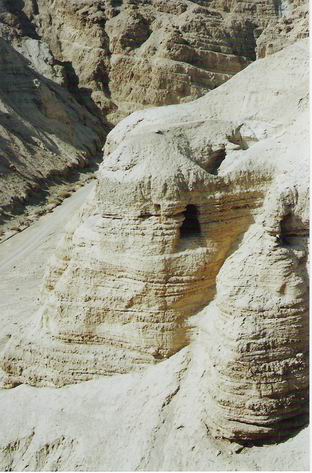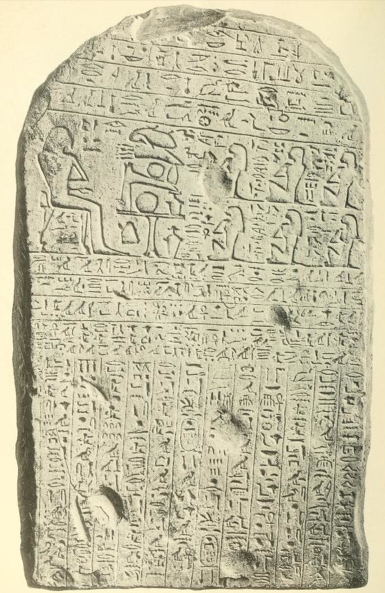|
Jehoiachin's Rations Tablets
Jehoiachin's rations tablets date from the 6th century BC and describe the oil rations set aside for a royal captive identified with Jeconiah, king of Judah. Tablets from the royal archives of Nebuchadnezzar king of Babylon were unearthed in the ruins of Babylon that contain food rations paid to captives and craftsmen who lived in and around the city. On one of the tablets, "Ya’u-kīnu, king of the land of Yahudu" is mentioned along with his five sons listed as royal princes. Excavation The tablets were excavated from Babylon during 1899–1917 by Robert Koldewey and were stored in a barrel-vaulted underground building consisting of rows of rooms near the Ishtar Gate. Translation The tablets' text states: Babylon 28122: "...t Ia-'-u-kin, king..." Babylon 28178: "10 (sila of oil) to ...Ia-'-kin, king of Ia ..2 sila to ..sos of the king of Ia-a-hu-du" Babylon 28186: "10 (sila) to Ia-ku-u-ki-nu, the son of the king of Ia-ku-du, 2 sila for the 5 sons of the king of Ia-ku-du" An ... [...More Info...] [...Related Items...] OR: [Wikipedia] [Google] [Baidu] |
Clay Tablet
In the Ancient Near East, clay tablets ( Akkadian ) were used as a writing medium, especially for writing in cuneiform, throughout the Bronze Age and well into the Iron Age. Cuneiform characters were imprinted on a wet clay tablet with a stylus often made of reed (reed pen). Once written upon, many tablets were dried in the sun or air, remaining fragile. Later, these unfired clay tablets could be soaked in water and recycled into new clean tablets. Other tablets, once written, were either deliberately fired in hot kilns, or inadvertently fired when buildings were burnt down by accident or during conflict, making them hard and durable. Collections of these clay documents made up the first archives. They were at the root of the first libraries. Tens of thousands of written tablets, including many fragments, have been found in the Middle East. Surviving tablet-based documents from the Minoan/ Mycenaean civilizations, are mainly those which were used for accounting. Tablets s ... [...More Info...] [...Related Items...] OR: [Wikipedia] [Google] [Baidu] |
Robert Koldewey
Robert Johann Koldewey (10 September 1855 – 4 February 1925) was a German archaeologist, famous for his in-depth excavation of the ancient city of Babylon in modern-day Iraq. He was born in Blankenburg am Harz in Germany, the duchy of Brunswick, and died in Berlin at the age of 69. His digs at Babylon revealed the foundations of the ziggurat Marduk, and the Ishtar Gate; he also developed several modern archaeological techniques including a method to identify and excavate mud brick architecture. This technique was particularly useful in his excavation of the Hanging Gardens of Babylon (1899–1917) which were built ca. 580 BC using mainly unfired mudbricks. A practicing archaeologist for most of his life, he participated in and led many excavations in Asia Minor, Greece, and Italy. After he died, the Koldewey Society was established to record and mark his architectural service.William M. Calder III, "Koldewey, Robert, 1855–1925"; in ''Encyclopedia of the History of Classical Ar ... [...More Info...] [...Related Items...] OR: [Wikipedia] [Google] [Baidu] |
Biblical Archaeology
Biblical archaeology is an academic school and a subset of Biblical studies and Levantine archaeology. Biblical archaeology studies archaeological sites from the Ancient Near East and especially the Holy Land (also known as Palestine, Land of Israel and Canaan), from biblical times. Biblical archaeology emerged in the late 19th century, by British and American archaeologists, with the aim of confirming the historicity of the Bible. Between the 1920s, right after World War I, when Palestine came under British rule and the 1960s, biblical archaeology became the dominant American school of Levantine archaeology, led by figures such as William F. Albright and G. Ernest Wright. The work was mostly funded by churches and headed by theologists. From the late 1960s, biblical archaeology was influenced by processual archaeology ("New Archaeology") and faced issues that made it push aside the religious aspects of the research. This has led the American schools to shift away from bi ... [...More Info...] [...Related Items...] OR: [Wikipedia] [Google] [Baidu] |
Clay Tablets
In the Ancient Near East, clay tablets (Akkadian ) were used as a writing medium, especially for writing in cuneiform, throughout the Bronze Age and well into the Iron Age. Cuneiform characters were imprinted on a wet clay tablet with a stylus often made of reed ( reed pen). Once written upon, many tablets were dried in the sun or air, remaining fragile. Later, these unfired clay tablets could be soaked in water and recycled into new clean tablets. Other tablets, once written, were either deliberately fired in hot kilns, or inadvertently fired when buildings were burnt down by accident or during conflict, making them hard and durable. Collections of these clay documents made up the first archives. They were at the root of the first libraries. Tens of thousands of written tablets, including many fragments, have been found in the Middle East. Surviving tablet-based documents from the Minoan/ Mycenaean civilizations, are mainly those which were used for accounting. Tablets servi ... [...More Info...] [...Related Items...] OR: [Wikipedia] [Google] [Baidu] |
6th-century BC Inscriptions
The 6th century is the period from 501 through 600 in line with the Julian calendar. In the West, the century marks the end of Classical Antiquity and the beginning of the Middle Ages. The collapse of the Western Roman Empire late in the previous century left Europe fractured into many small Germanic kingdoms competing fiercely for land and wealth. From the upheaval the Franks rose to prominence and carved out a sizeable domain covering much of modern France and Germany. Meanwhile, the surviving Eastern Roman Empire began to expand under Emperor Justinian, who recaptured North Africa from the Vandals and attempted fully to recover Italy as well, in the hope of reinstating Roman control over the lands once ruled by the Western Roman Empire. In its second Golden Age, the Sassanid Empire reached the peak of its power under Khosrau I in the 6th century.Roberts, J: "History of the World.". Penguin, 1994. The classical Gupta Empire of Northern India, largely overrun by the Huna, ended ... [...More Info...] [...Related Items...] OR: [Wikipedia] [Google] [Baidu] |
Biblical Archaeology (excavations And Artifacts)
Biblical archaeology is an academic school and a subset of Biblical studies and Levantine archaeology. Biblical archaeology studies archaeological sites from the Ancient Near East and especially the Holy Land (also known as Palestine, Land of Israel and Canaan), from biblical times. Biblical archaeology emerged in the late 19th century, by British and American archaeologists, with the aim of confirming the historicity of the Bible. Between the 1920s, right after World War I, when Palestine came under British rule and the 1960s, biblical archaeology became the dominant American school of Levantine archaeology, led by figures such as William F. Albright and G. Ernest Wright. The work was mostly funded by churches and headed by theologists. From the late 1960s, biblical archaeology was influenced by processual archaeology ("New Archaeology") and faced issues that made it push aside the religious aspects of the research. This has led the American schools to shift away from bi ... [...More Info...] [...Related Items...] OR: [Wikipedia] [Google] [Baidu] |
List Of Artifacts Significant To The Bible
The following is a list of inscribed artifacts, items made or given shape by humans, that are significant to biblical archaeology. Selected artifacts significant to biblical chronology These table lists inscriptions which are of particular significance to the study of biblical chronology. The table lists the following information about each artifact: ;Name: In English ;Current location: Museum or site ;Discovered: Date and location of discovery ;Date: Proposed date of creation of artifact ;Writing: Script used in inscription (if any) ;Significance: Reason for significance to biblical archeology ;Refs: ANET and COS references, and link to editio princeps (EP), if known Egyptian Other significant Egyptian artifacts * Execration texts – earliest references to many Biblical locations * Papyrus Brooklyn 35.1446– A document that lists the names of 45 individuals, including a Canaanite woman named "Šp-ra." Scholars assume that this is a hieroglyphic transliteration of the Heb ... [...More Info...] [...Related Items...] OR: [Wikipedia] [Google] [Baidu] |
Ancient Mesopotamian Units Of Measurement
Ancient Mesopotamian units of measurement originated in the loosely organized city-states of Early Dynastic Sumer. Each city, kingdom and trade guild had its own standards until the formation of the Akkadian Empire when Sargon of Akkad issued a common standard. This standard was improved by Naram-Sin, but fell into disuse after the Akkadian Empire dissolved. The standard of Naram-Sin was readopted in the Ur III period by the Nanše Hymn which reduced a plethora of multiple standards to a few agreed upon common groupings. Successors to Sumerian civilization including the Babylonians, Assyrians, and Persians continued to use these groupings. Akkado-Sumerian metrology has been reconstructed by applying statistical methods to compare Sumerian architecture, architectural plans, and issued official standards such as Statue B of Gudea and the bronze cubit of Nippur. Archaic system The systems that would later become the classical standard for Mesopotamia were developed in parall ... [...More Info...] [...Related Items...] OR: [Wikipedia] [Google] [Baidu] |
King Of Judah
The Kings of Judah were the monarchs who ruled over the ancient Kingdom of Judah. According to the biblical account, this kingdom was founded after the death of Saul, when the tribe of Judah elevated David to rule over it. After seven years, David became king of a reunited Kingdom of Israel. However, in about 930 BCE the united kingdom split, with ten of the twelve Tribes of Israel rejecting Solomon's son Rehoboam as their king. The tribes of Judah and Benjamin remained loyal to Rehoboam, and re-formed the Kingdom of Judah, while the other entity continued to be called the Kingdom of Israel, or just Israel. The capital of the Kingdom of Judah was Jerusalem. All of the kings of Judah lived and died in Judah except for Ahaziah (who died at Megiddo in Israel), Jehoahaz (who died a prisoner in Egypt) and Jeconiah and Zedekiah who were deported as part of the Babylonian captivity. Judah was conquered in 587 or 586 BC, by the Neo-Babylonian Empire under Nebuzaradan, captain of Nebuc ... [...More Info...] [...Related Items...] OR: [Wikipedia] [Google] [Baidu] |
Byblos
Byblos ( ; gr, Βύβλος), also known as Jbeil or Jubayl ( ar, جُبَيْل, Jubayl, locally ; phn, 𐤂𐤁𐤋, , probably ), is a city in the Keserwan-Jbeil Governorate of Lebanon. It is believed to have been first occupied between 8800 and 7000BC and continuously inhabited since 5000BC, making it one of the oldest continuously inhabited cities in the world. During its history, Byblos was part of numerous civilizations, including Egyptian, Phoenician, Assyrian, Persian, Hellenistic, Roman, Fatimid, Genoese, Mamluk and Ottoman. The city is a UNESCO World Heritage Site. It was in ancient Byblos that the Phoenician alphabet, likely the ancestor of the Greek, Latin and all other Western alphabets, was developed. Etymology Byblos appears as ''Kebny'' in Egyptian hieroglyphic records going back to the 4th-dynasty pharaoh Sneferu (BC) and as () in the Akkadian cuneiform Amarna letters to the 18th-dynasty pharaohs and IV. In the 1stmillenniumBC, its n ... [...More Info...] [...Related Items...] OR: [Wikipedia] [Google] [Baidu] |
Arvad
Arwad, the classical Aradus ( ar, أرواد), is a town in Syria on an eponymous island in the Mediterranean Sea. It is the administrative center of the Arwad Subdistrict (''nahiyah''), of which it is the only locality.General Census of Population and Housing 2004 Syria Central Bureau of Statistics (CBS). Latakia Governorate. It is the only inhabited island in Syria. It is located from (the ancient Tortosa), Syria's second-largest port. Today, Arwad is mainly a fishing t ... [...More Info...] [...Related Items...] OR: [Wikipedia] [Google] [Baidu] |
Babylon
''Bābili(m)'' * sux, 𒆍𒀭𒊏𒆠 * arc, 𐡁𐡁𐡋 ''Bāḇel'' * syc, ܒܒܠ ''Bāḇel'' * grc-gre, Βαβυλών ''Babylṓn'' * he, בָּבֶל ''Bāvel'' * peo, 𐎲𐎠𐎲𐎡𐎽𐎢 ''Bābiru'' * elx, 𒀸𒁀𒉿𒇷 ''Babili'' *Kassite: ''Karanduniash'', ''Karduniash'' , image = Street in Babylon.jpg , image_size=250px , alt = A partial view of the ruins of Babylon , caption = A partial view of the ruins of Babylon , map_type = Near East#West Asia#Iraq , relief = yes , map_alt = Babylon lies in the center of Iraq , coordinates = , location = Hillah, Babil Governorate, Iraq , region = Mesopotamia , type = Settlement , part_of = Babylonia , length = , width = , area = , height = , builder = , material = , built = , abandoned = , epochs = , cultures = Sumerian, Akkadian, Amorite, Kassite, Assyrian, Chaldean, Achaemenid, Hellenistic, Parthian, Sasanian, Muslim , dependency_of = , occupants = , event = , excavations = , archaeologists = Hormuzd Rassam, Ro ... [...More Info...] [...Related Items...] OR: [Wikipedia] [Google] [Baidu] |







